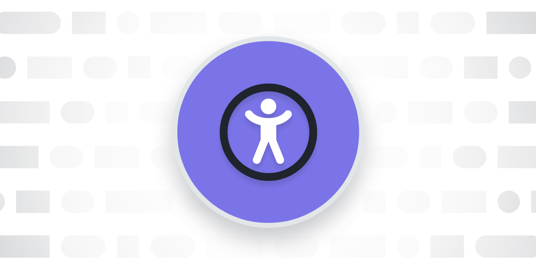An estimated 15% of the world’s population lives with a disability, and the pressure to deliver accessible web applications to these consumers only continues to grow. Although accessibility testing has been difficult for many software teams, the Americans with Disabilities Act and a rising number of lawsuits are pushing organizations to create quality digital experiences for everyone.
In this guide, we’ll cover what web accessibility testing is and some of the most common guidelines for accessible user interfaces. We’ll also discuss challenges and strategies for integrating web accessibility testing into DevOps.
What Is Web Accessibility Testing?
Web accessibility testing is a software testing method for assessing websites, apps, and digital experiences for inclusivity and usability. The aim of accessibility testing is to ensure that users with visual impairments or other disabilities, including those that require assistive technologies like screen readers, can access and use the software. By adopting web accessibility testing processes, organizations can comply with international standards for website accessibility and deliver better user experiences.
Accessibility testing processes can include a combination of automated tools and manual testing techniques to identify potential barriers users might face. Ideally, a software organization leverages multiple techniques to ensure effective website accessibility testing at scale. Automated tests can discover common accessibility issues like missing form labels, insufficient image alternative text (“alt” text), and non-descriptive hyperlinks. While manual testing performed by quality engineers or developers can assess color contrasts and text readability.
WCAG Requirements for Building an Accessible Application
When getting started with accessibility testing, it’s important to understand the elements of an accessible user interface. A great starting point is the Web Content Accessibility Guidelines (WCAG), an international standard that meets or exceeds the accessibility requirements in many countries.
The WCAG standards have 12-13 guidelines that are organized under the principles of perceivable, operable, understandable, and robust. These four principles are necessary for anyone to access and use web content. The guidelines also have three levels of success criteria that determine conformance to WCAG and help organizations adhere to the four principles: A, AA, and AAA.
It’s worth noting that AAA conformance is not recommended as a general policy since it’s not possible to meet it for some web content. Many organizations may find themselves between levels, especially as they start their accessibility improvements.
Based on WCAG, here are three critical website accessibility issues and how they can be tested with automated accessibility checks.
Label form element tests
Labeling form elements, like buttons, is an important way to make interacting with a web page more accessible to those with vision impairments or blindness. Accessibility tests that check the UI for clear form labels help ensure screen readers can understand the web page and successfully navigate a website. These checks also support SEO (search engine optimization) efforts because it helps add context for search engines.
Color contrast tests
For those with vision issues that don’t necessarily need a screen reader, improving the color contrast of buttons and other visual elements can still make their experience easier. Accessibility tests that ensure web pages have high-contrast color schemes can make websites clearer and easier to use for everyone, improving the overall customer experience.
Starker text tests
Similarly, starker text that stands out from other visual elements makes web content easier to read. Accessibility tests that evaluate text font, size, and color as well as the background image or pattern can lead to better reading experiences.
Challenges With Accessibility Testing in DevOps
Although accessibility is a pressing concern for many organizations, it’s often unclear who owns accessibility testing. Software teams are focused on development velocity and don’t have a lot of resources to add accessibility testing to their workflows. Meanwhile, legal teams are most concerned about maintaining compliance with accessibility regulations and don’t have experience with building digital experiences.
Bridging the gap between compliance and engineering requires an accessibility testing strategy in DevOps that allows accessibility experts to translate accessibility standards to the entire team while also matching the pace of development.
Automated testing helps software development and compliance teams streamline web accessibility testing so that accessibility standards, such as the WCAG, can be consistently upheld. As a primary advocate for the customer experience within the development organization, quality professionals are well-positioned to support and lead the introduction of accessibility testing.
The practice of quality engineering ensures quality assurance teams can expand their software testing efforts to include accessibility testing without slowing down development.
Best Methods to Automate Web Accessibility Testing
Companies that adopt DevOps usually release code on a daily basis, so each part of the development process needs to be repeatable and collaborative. This requires automated accessibility testing using tools that easily integrate with existing DevOps pipelines.
Beyond integrating with DevOps tools, automated website accessibility testing mandates solutions that reduce the time and effort needed to perform accessibility checks. Test automation platforms that allow QA teams to embed an accessibility check into an existing functional test, for example, is an easy way to start testing for accessibility. These tests should cover as much of the user experience as possible, including the entire DOM, to minimize the risk of testing gaps. Embedding these automated accessibility checks early and often helps software teams get the feedback they need to resolve accessibility issues more efficiently.
As mentioned before, the accessibility expertise often resides outside the development organization, usually with the legal team. Even if an organization has a dedicated accessibility lead within their development organization, they need tools and processes that make it easy to share knowledge with developers and QA in an actionable way.
This means software and accessibility experts need processes in place to collaborate with each other and ensure they’re meeting accessibility regulatory requirements. Testing tools that allow QA teams to create customized tests with specific error messages can help embed accessibility knowledge into testing workflows. This makes it easier for quality professionals and developers to quickly understand what issues need to be fixed to meet accessibility standards. Trend reports and metrics based on automated test results can also help break down knowledge gaps and support organizations as they create shared goals to improve the digital experience for everyone.
Accessibility Testing Metrics to Monitor in DevOps
Once companies can run accessibility tests within their DevOps pipelines, they’ll also be able to identify trends and issues more frequently. These insights will help software teams focus their efforts on the most critical accessibility issues that have the greatest impact on inclusivity and usability.
There are a number of accessibility testing metrics that are worth monitoring, including:
- Accessibility Test Coverage: The percentage of code or UI elements that have tests for evaluating accessibility.
- Amount/Severity of Accessibility Issues: These metrics can give quality engineers an indication of the application’s overall accessibility.
- Time to Resolve Accessibility Issues: Measuring the average time it takes to address accessibility issues helps teams identify and eliminate remediation bottlenecks.
- Compliance with Accessibility Standards: A benchmark for the level of compliance with WCAG or other accessibility standards.
Tools for Running Web Accessibility Tests
There are a wide range of automated testing tools for different functional and non-functional testing strategies, but a complex testing tech stack is more difficult to manage, not to mention more costly. To get the most value out of their tools and their people, companies need tools with the ability to scale accessibility test coverage as their product evolves.
Choosing a test automation partner that allows everyone to contribute to accessibility, integrate testing deeper into their development pipeline, and test the entire customer experience is essential for sustainably adopting accessibility testing. This also helps quality engineers integrate accessibility testing into their larger software testing strategy.
Mabl is a low-code test automation solution that makes accessibility testing easy. Your team can execute accessibility checks within existing functional UI tests to identify and resolve accessibility issues earlier in the development process. Pre-built dashboards help you report the status of critical accessibility issues and track progress across your organization. This empowers your team to build more inclusive and accessible applications that deliver great digital experiences to all customers.
Ready to get started with accessibility testing? Register for a free trial to discover how easy mabl makes it to run accessibility tests.






